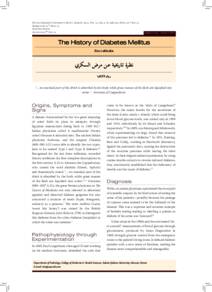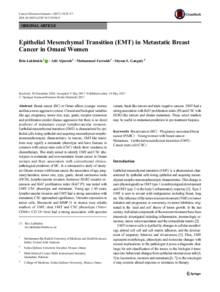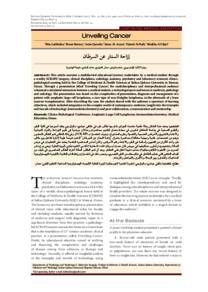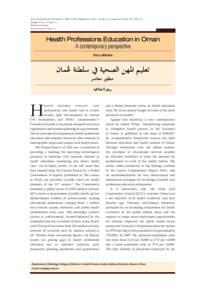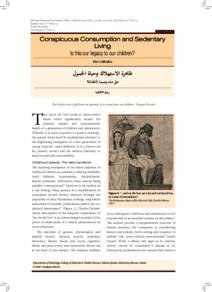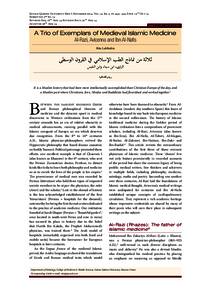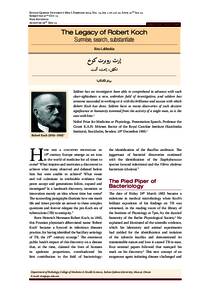Document
The History of diabetes mellitus.
Other titles
نظرة تاريخية عن مرض السكري
Publisher
College of Medicine and Health Science, Sultan Qaboos University.
Gregorian
2013-08
Language
English
Subject
English abstract
A disease characterised by the 'too great emptying of urine' finds its place in antiquity through Egyptian manuscripts dating back to 1500 B.C.1 Indian physicians called it madhumeha ('honey urine') because it attracted ants. The ancient Indian physician, Sushruta, and the surgeon Charaka (400–500 A.D.) were able to identify the two types, later to be named Type I and Type II diabetes.2,3 Recognised for the last three millennia, recorded history attributes the first complete descriptions in the first century A.D. 1. The antiquity of early descriptions of diabetes underscores the importance of the observation and recording of medical conditions as humans evolve. Early physicians used whatever was in their capacity (smell or even taste!) in pursuit of knowledge, skills and diagnosis. 2. Age is no bar to contributing significantly to the profession; Langerhans, was a 22 year old student when he wrote a thesis identifying the cells that werelater known to be the source of insulin production. 3. Despite accounts of the acrimonious 'team' interactions building up to and following the groundbreaking discovery of insulin, the acknowledgement of fellow professionals is illustrated in Banting and Macleod's (Noble laureates) recognition of Best and Collip's immense contributions by sharing their Noble prize money with them. 4. The refusal to patent insulin but to share this miraculous therapy freely with the world will remain an outstanding example of unreserved generosity towards mankind in the history of medical disease. Banting's colossal contribution has been globally recognised by the declaration, since 2007, of his birthday (14th November) as World Diabetes Day. From unrecorded accounts to published knowledge, this human scourge is, simply put, a modern day epidemic. We, and future generations of medical professionals, share the task of taking this history forward.
Member of
Resource URL
Arabic abstract
وجد مرض يتميز بـ "إفراغ مفرط للبول" مكانه في العصور القديمة من خلال المخطوطات المصرية التي يعود تاريخها إلى 1500 قبل الميلاد. أطلق عليها الأطباء الهنود المادومة ("بول العسل") لأنها تجتذب النمل. تمكّن الطبيب الهندي القديم ، سوشروتا ، والجراح شاراكا (400-500 م) من تحديد النوعين ، وسُميّا فيما بعد بمرض السكري من النوع الأول والنوع الثاني. أول أوصاف كاملة في القرن الأول بعد الميلاد. 1. تؤكد الأوصاف القديمة لمرض السكري على أهمية مراقبة وتسجيل الحالات الطبية مع تطور البشر. استخدم الأطباء الأوائل كل ما في وسعهم (رائحة أو حتى طعم!) في السعي وراء المعرفة والمهارات والتشخيص. 2. العمر ليس عائقا للمساهمة بشكل كبير في المهنة. لانجرهانز ، كان طالبًا يبلغ من العمر 22 عامًا عندما كتب أطروحة تحدد الخلايا التي عرفت لاحقًا أنها مصدر إنتاج الأنسولين. 3. على الرغم من الروايات عن تفاعلات "الفريق" الحادة التي تتراكم مع الاكتشاف الرائد للأنسولين وبعده ، يتضح تقدير زملائه المهنيين في تقدير Banting و Macleod (الحائزين على جائزة نوبل) لمساهمات Best and Collip الهائلة من خلال تقاسم أموال جائزة نوبل. معهم. 4. إن رفض منح براءة اختراع للأنسولين مع مشاركة هذا العلاج الخارق بحرية مع العالم سيظل مثالاً بارزًا على الكرم غير المتحفظ تجاه البشرية في تاريخ الأمراض الطبية. تم الاعتراف بمساهمة بانتينج الهائلة عالميًا من خلال الإعلان ، منذ عام 2007 ، عن عيد ميلاده (14 نوفمبر) اليوم العالمي للسكري. من الروايات غير المسجلة إلى المعرفة المنشورة ، فإن هذه الآفة البشرية هي ببساطة وباء معاصر. نحن ، والأجيال القادمة من المهنيين الطبيين ، نتشارك مهمة دفع هذا التاريخ إلى الأمام.
Category
Journal articles

